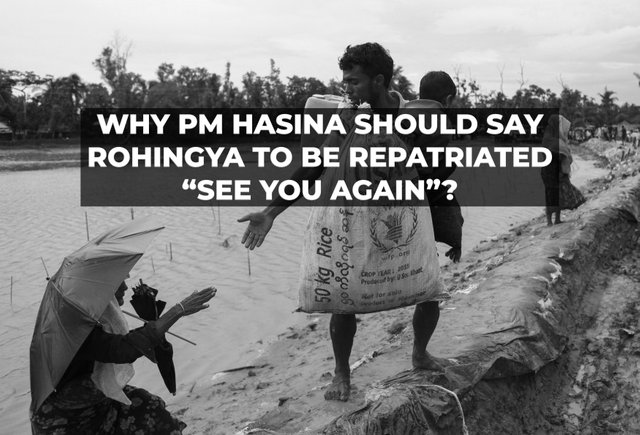Rohingya: Circle of Exodus

By Qutub Shah
Rohingya Vision
Since the late 18th century, Arakan has been a region of intermittent violence against Arakanese Rohingya causing refugee flows occasionally. The major outflows were in 1784, 1942, 1978, 1991-92, 2012 and 2016-17, whereas estimated 10,000 Rohingya flee yearly, according to right groups.
As many people focus on post-colonial history and exoduses since 1978, it’s not enough to realize the falsity of Burma’s accusation of “illegal immigration”. Though there were the official repatriation of majority refugees in 78 and 92, and are preparations in the most recent exodus, the refugees in the late 1700s and early 1800s and in 1940s never returned to Burma, but instead, they settled down in the area of Cox’s Bazar and became integrated with the local community.
Though Rohingyas were once part of Rohang (Mrouk-U) sovereignty, prosperity, civilization and politics, they were made not only stateless but also homeless by Burma because of their ethnic and religious background.
In addition, they were labeled as illegal immigrants of the colonial era, just because since the fall of Arakan in 1784 until 2018, comparatively that was the only period where Rohingya enjoyed some sorts of freedom.
A historic overview of the circle of exodus not only serves to reveal the centuries old suffering of Arakanese Rohingya but also traces their original attachment to the soil of Arakan and thus their firmly established link to the modern Burma that occupied their land.
1784 The Fall of Arakan
When Burma completely occupied Arakan on December 28, 1784, about 30 thousand Rohingya fled to southern Bengal in the first wave. Following the fall of Arakan into the hand of Burmans, their aggressions against Arakanese Rohingya escalated day by day and accordingly increased their influx into southern Bengal until the refugees were counted in hundreds of thousands in the 1790s.
In 1790, Hiram Cox was appointed by the East India Co. as the Superintendent for the rehabilitation of these refugees in Southern Bengal. He resettled them there and it was the refugees from Arakan who constituted the bulk of the original settlers around Cox's Bazar. He established the city, after whom Cox's Bazar was named. The refugees from invasion attack of 1784 never came back to Arakan.
1942 Muslim Massacre
Again in 1942 during the colonial era, Magh and Burman Thakin nationalists conducted a massive massacre against Rohingya on 28 March. Tens of thousands were killed while more than 80 thousand of the survivors took refuge in Chittagong, Subrinagar, Rangpur, Dinazpur, etc. Those refugees were not repatriated back to Burma.
1978 The Dragon Operation
In 1978, the Dragon Operation under the dictator Ne Win govt that started on Feb 11, 1978, from Akyab forced more than 250 thousand out. Between 31 August and 29 Dec 1978, 252,000 refugees were listed while the number might exceed 300,000 including unregistered ones.
A repatriation agreement between Bangladesh and Burma was signed on 9 July 1978, and later on, 187,250 refugees were repatriated to their native land.
Refugees not willing to return voluntarily were forced for repatriation. In order to induce them to return to their homeland, the ration was restricted and food held back, resorting to violence sometimes. In result, more than 10,000 refugees lost their lives due to malnutrition, shortage of food and medicine, etc.
As the Dragon Operation failed to exterminate Rohingya and Burma had to take them back from Bangladesh, the government adopted a new measure to exclude Rohingya by amending citizenship law in 1982.
1991-92 Na Sa Ka Operation
Under this black law of citizenship, another major exodus took place in 1991-92. In the SLORC of Saw Maung, by March 1992, around 260,000 Rohingya escaped to Bangladesh from Na Sa Ka operation known as Pyi Thar Yar, who ruled them by a regional order and persecuted them.
On April 28, 1992, a repatriation MoU was signed by both governments. Within few years, 236,599 refugees were repatriated and the rest are still in refugee camps of Bangladesh.
Refugees who did not agree to return were forced, imprisoned, beaten or threatened, and rations were restricted, even the UNHCR withdrew from all the camps in protest against local in-charges.
2012 Anti-Rohingya Violence
In 2012, during USDP govt of Thein Sein, an anti-Rohingya violence sparked from the attack on 10 pilgrims on 3rd June in Kyaukpyu by Magh extremists, causing displacement of about 250,000 Rohingyas, of whom three-fifths are internally displaced persons in their homeland.
Those internally or internationally displaced persons of 2012 massacre were neither repatriated nor relocated.
2016-17 Cleansing Operations
Finally, on 9 October 2016 and again on 25 August 2017, some major cleansing operations were conducted under NLD govt of Suu Kyi, resulting in a historical exodus of over one million refugees. Though a repatriation agreement was signed by the two countries on 23 Nov 2017, physical repatriation is to be started yet.
According to sources, 90% of Rohingya population is made refugees, and the number of Rohingya remaining in Arakan will hardly exceed 500,000.
The refugees who fled in 1784 and 1942 were deprived of their homeland permanently. And the refugees of 1978 and 1991-92 were also not completely repatriated. Then who and where is the illegal immigrant?
In the most recent exodus, efforts are being made to repatriate the refugees. In the premature repatriation without their rights guaranteed like before, Bangladesh should say to them, "See you again". But this time, an end must be put to this circle of Exodus!
Posted from my blog with SteemPress : http://www.rvisiontv.com/rohingya-circle-of-exodus/